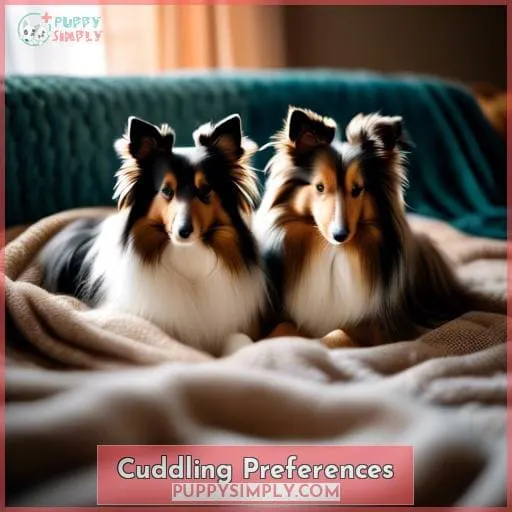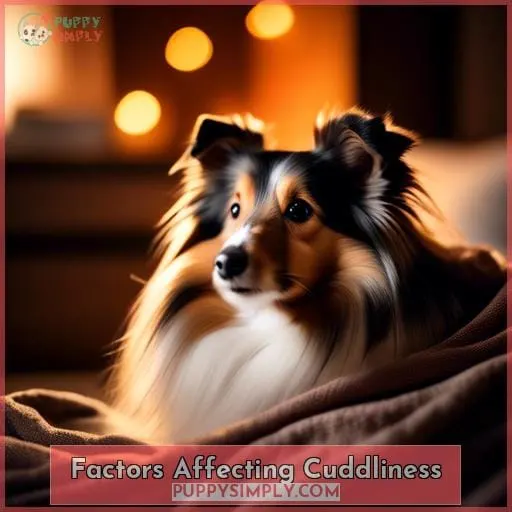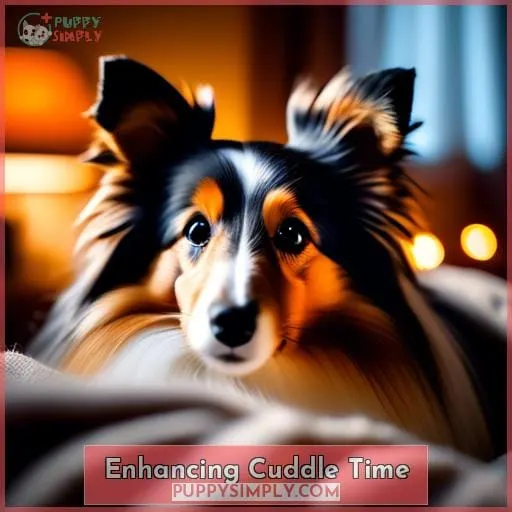This site is supported by our readers. We may earn a commission, at no cost to you, if you purchase through links.
 As pack animals needing constant company, Shelties crave close bonds.
As pack animals needing constant company, Shelties crave close bonds.
Their affectionate nature makes them prone to cuddling, though temperaments vary.
We’ll explore evidence on the Sheltie cuddle factor – from their heritage as loyal Scottish island herders to those velcro-dog tendencies to cling.
What sways some to snuggle more?
Does health or age change cuddliness?
You’ll discover research-backed insights on enhancing cuddle time with this high-spirited breed.
Table Of Contents
- Key Takeaways
- Sheltie History
- Sheltie Temperament
- Cuddling Preferences
- Factors Affecting Cuddliness
- Enhancing Cuddle Time
- Expressions of Affection
- Frequently Asked Questions (FAQs)
- How can I get my Sheltie puppy to enjoy cuddling more as it gets older?
- What are some signs my Sheltie wants to cuddle or needs more affection?
- At what age do Shelties start to enjoy cuddling and being held?
- How much daily affection and cuddling do Shelties need?
- Are male or female Shelties more likely to enjoy cuddling and physical affection?
- Conclusion
Key Takeaways
- Shelties are affectionate dogs that bond closely with their owners, but individual preferences for physical affection vary.
- Factors like age, energy level, socialization, training, and overall temperament impact a Sheltie’s desire to cuddle.
- Creating positive associations with touch and physical affection from a young age can enhance a Sheltie’s enjoyment of cuddling.
- Understanding a Sheltie’s unique personality and preferences, while also providing proper outlets for exercise and autonomy, facilitates increased opportunities for cuddle time.
Sheltie History
As a herding breed that originated in the Shetland Islands of Scotland, Shelties were bred to have a gentle yet energetic temperament to manage sheep and ponies.
Their loyal and affectionate nature, cultivated over generations by living and working closely with farmers, translates well into enjoying cuddles and physical affection from their human families today.
Understanding the Sheltie’s origins as a herding companion that thrived on close bonds with people provides insight into why they make such cuddly pets.
Origin and Evolution
You’re likely familiar with the herding breeds called Collies.
Shelties actually originated from those pups on the Shetland Islands of Scotland, where their smaller size helped them nimbly herd sheep, ponies, and chickens in the harsh northern climate.
Genetic influences from Collies combined with ecological factors like the rugged terrain and inclement weather of the Shetland Islands led to evolutionary adaptations that produced the Sheltie breed’s compact size, thick coat, energetic temperament, herding instincts, and affectionate nature.
Role in Herding
These dogs’ original purpose was to herd livestock in the harsh Shetland climate, so you’d work them to move sheep and cattle across rugged landscapes.
Their strong herding instincts and agility made them ideal for maneuvering and gathering livestock, while their intelligence and eagerness to please enabled training them for shepherd duties.
Their legacy remains in their alert, energetic temperaments.
Sheltie Temperament
As herding dogs bred to work closely with people, Shelties tend to be energetic, playful, intelligent, and eager to please.
Their sensitive natures make them affectionate companions who form strong bonds with their owners.
However, Shelties can be wary of strangers and prone to separation anxiety when left alone.
Energetic and Playful
You’ll frequently encounter Shelties bursting with energy and eagerly initiating play.
Their lively temperaments thrive on interactive games and bonding activities that provide essential mental stimulation, exercise, and socialization benefits for these affectionate yet prone-to-separation-anxiety lap dogs.
Intelligent and Sensitive
You will find these herding dogs to be bright and attentive to your moods.
Intelligent bonding through training and play.
Emotional responsiveness by comforting you when sad.
Social interaction by initiating play or seeking affection.
Sensory engagement using sight and hearing to understand cues.
They adapt behaviors based on your actions, wanting to please you.
Cuddling Preferences
When it comes to cuddling, individual Shelties can vary in their preferences.
A Sheltie’s age, activity level, training, and temperament can impact how much they enjoy physical affection.
A Sheltie may be too energetic and excitable to settle down for cuddles as a young pup.
An older Sheltie may enjoy curling up with their owner in the evenings.
Individual Variability
Your Sheltie’s desire for cuddling depends on their unique personality.
Genetically predisposed traits interact with each dog’s upbringing and conditioning to shape preferences.
While most bond closely and crave affection, some remain more aloof or independent.
Ensure your Sheltie feels safe and comfortable, never forcing closeness.
Respect their space and signals.
With positive socialization and conditioning, you can enhance cuddle time for willing canine companions.
Age and Activity Level
A Sheltie puppy’s high energy level may make it less inclined to cuddle.
Though it may become more affectionate as it matures.
Puppies are often too energetic and excitable to settle for cuddles.
Adolescent and adult Shelties tend to calm down and enjoy more physical affection.
An older Sheltie may seek more cuddles as it slows down in its senior years.
Factors Affecting Cuddliness
Some Shelties may be more independent or prefer cuddling only at certain times.
A Sheltie’s environment and health can also impact its desire for physical affection.
Understanding what motivates your Sheltie’s behavior can help you bond.
Independence Vs. Affection
Although Shelties are generally affectionate dogs who enjoy cuddling, some factors can affect an individual Sheltie’s desire for affection.
Don’t be discouraged if your Sheltie seems more independent.
Factors:
- Independence: Some Shelties may be more independent and desire more personal space.
- Bonding: Early socialization and bonding with owners enhances a Sheltie’s desire for companionship and closeness.
- Autonomy: Providing adequate outlets for a Sheltie’s need for autonomy can increase their willingness for affection and interaction.
- Emotional Needs: Understanding and accommodating your Sheltie’s unique emotional needs can lead to greater intimacy and belonging.
Environmental and Health Influences
You’re losing cuddle time with your Sheltie if their environment makes them uncomfortable or if health issues go untreated.
Consider any fears, stressors, or discomforts like loud noises, tight spaces, or hot temperatures that prevent your Sheltie from relaxing into your embrace.
Also monitor for pain, illness, or injury that could make cuddling unpleasant.
With a peaceful setting and good health, your Sheltie will eagerly snuggle in your comforting arms.
Enhancing Cuddle Time
To get the most enjoyment from cuddling your Sheltie:
- Focus on their comfort and safety.
- Train them to seek affection.
Use treats and praise to reward snuggling.
Make sure not to force interaction if your dog seems uncomfortable.
Creating positive associations with physical touch from puppyhood will make your Sheltie more likely to initiate and enjoy cuddle time.
Comfort and Safety
You’ll want to consider your Sheltie’s comfort and safety when enhancing cuddle time.
Choose a quiet area free of loud noises or other pets that may startle them.
Don’t force a hug if they show signs of discomfort.
Provide cool water and monitor their temperature to prevent overheating.
With some accommodations, you can make cuddling an enjoyable experience for both you and your Sheltie.
- Soft beds
- Familiar scents
- Positive reinforcement
Training for Affection
With your training and affection, you can enhance cuddle time with your Sheltie.
Use positive reinforcement like treats and praise to reward cuddling.
Incorporate bonding exercises and socialization techniques to build trust and comfort being held.
Affection training when young establishes desired behaviors.
But be patient, as each Sheltie has unique preferences.
Respect those while fostering closeness through understanding and care.
Expressions of Affection
Beyond cuddling, it’s important to recognize the more subtle signs of affection Shelties display.
They express their devotion through actions like:
- Following you room to room
- Whining for attention
- Sleeping near you
- Licking your face
- Bringing you toys
Paying attention to these behaviors will help you better understand your Sheltie’s loving nature.
Beyond Cuddling
You can also recognize a Sheltie’s affection through subtle signs:
- Following you from room to room
- Whining for attention
- Sleeping nearby
- Wagging their tail
- Bringing you toys
Playful interactions and non-verbal communication show their desire for social bonding and emotional connection through interactive engagement.
Recognizing Subtle Signs
When someone wants your attention, you’ll notice a Sheltie nuzzling your hand, softly whining, or staring with those big eyes.
Tail wagging, soft whimpers, nudging hands, perked-up ears, and tracking your every move are all ways these sensitive canines communicate their need for human connection.
Understanding their social body language and vocal cues is key to recognizing a Sheltie’s subtle expressions of affection.
Frequently Asked Questions (FAQs)
How can I get my Sheltie puppy to enjoy cuddling more as it gets older?
Provide positive reinforcement when your Sheltie puppy engages in cuddling.
Start small with brief cuddle sessions, then gradually increase the duration as it becomes comfortable.
Be patient and consistent, cuddling at scheduled times.
Socialize extensively so it develops confidence around people.
Meet its needs for exercise and mental stimulation first so it’s relaxed and receptive to affection.
What are some signs my Sheltie wants to cuddle or needs more affection?
Coming to sit or lie near you,
Pawing at you, staring intently,
Licking your hand or face,
Bringing a toy to you,
Leaning against you,
Following you closely from room to room,
And wagging tail when you pet them.
Respond by initiating cuddling.
At what age do Shelties start to enjoy cuddling and being held?
You’ll often see Sheltie puppies start enjoying cuddles around 3-4 months old, when their boundless energy begins to settle.
As they mature into adulthood, most Shelties crave the comfort of their owner’s arms, drawn by an intuitive need for companionship.
With affection and training, these sensitive souls warm up to snuggling in due time.
How much daily affection and cuddling do Shelties need?
Shelties require at least 30-60 minutes of affection with their owner daily.
This bonding time fulfills their need for close companionship, reduces separation anxiety, and strengthens your relationship.
Make it a consistent routine with varied activities like petting, gentle stroking, brushing, playtime, training games, or just relaxing together.
Are male or female Shelties more likely to enjoy cuddling and physical affection?
Ultimately, there’s no significant difference in cuddliness between male and female Shelties.
Their desire for affection stems from breeding and socialization, not gender.
Focus on choosing the individual dog with the ideal temperament for you.
Conclusion
Have you ever seen a Sheltie nestle into the crook of their owner’s arm for a nap?
This breed craves affection.
From their loyal herding past to their sensitive temperament, Shelties need companionship.
Respect your pup’s preferences, but engage through play and training.
With patience, you may find more cuddle time with your energetic Sheltie.
Ultimately, these quick-witted pups express love in many ways – stay alert for subtle signs beyond snuggling that they long for your companionship.












